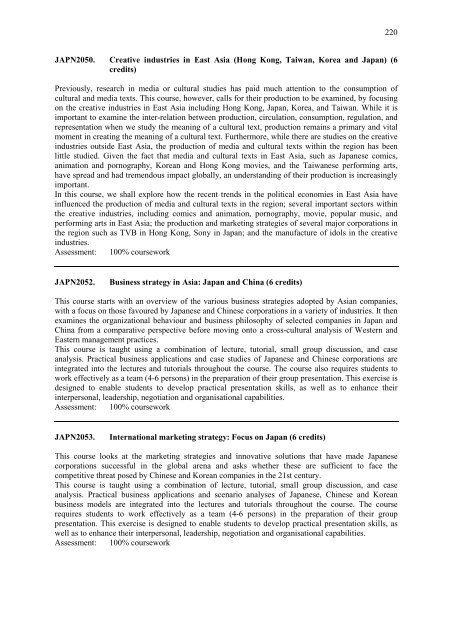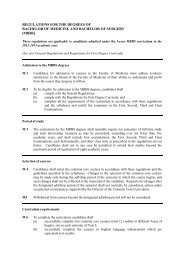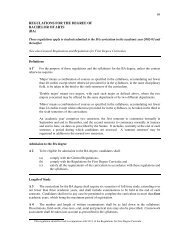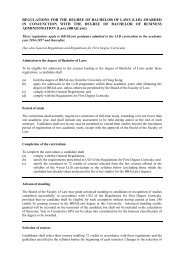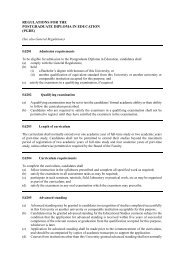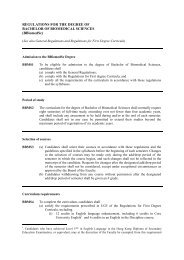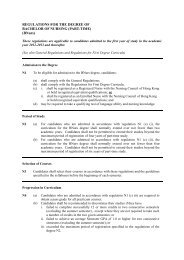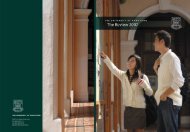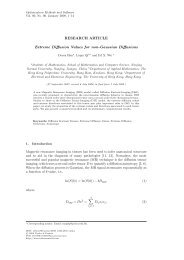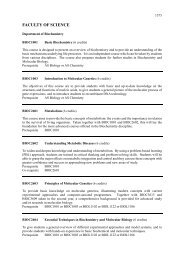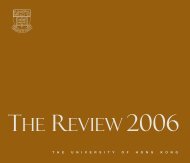(BA) (4-year-programme) - The University of Hong Kong
(BA) (4-year-programme) - The University of Hong Kong
(BA) (4-year-programme) - The University of Hong Kong
Create successful ePaper yourself
Turn your PDF publications into a flip-book with our unique Google optimized e-Paper software.
220JAPN2050. Creative industries in East Asia (<strong>Hong</strong> <strong>Kong</strong>, Taiwan, Korea and Japan) (6credits)Previously, research in media or cultural studies has paid much attention to the consumption <strong>of</strong>cultural and media texts. This course, however, calls for their production to be examined, by focusingon the creative industries in East Asia including <strong>Hong</strong> <strong>Kong</strong>, Japan, Korea, and Taiwan. While it isimportant to examine the inter-relation between production, circulation, consumption, regulation, andrepresentation when we study the meaning <strong>of</strong> a cultural text, production remains a primary and vitalmoment in creating the meaning <strong>of</strong> a cultural text. Furthermore, while there are studies on the creativeindustries outside East Asia, the production <strong>of</strong> media and cultural texts within the region has beenlittle studied. Given the fact that media and cultural texts in East Asia, such as Japanese comics,animation and pornography, Korean and <strong>Hong</strong> <strong>Kong</strong> movies, and the Taiwanese performing arts,have spread and had tremendous impact globally, an understanding <strong>of</strong> their production is increasinglyimportant.In this course, we shall explore how the recent trends in the political economies in East Asia haveinfluenced the production <strong>of</strong> media and cultural texts in the region; several important sectors withinthe creative industries, including comics and animation, pornography, movie, popular music, andperforming arts in East Asia; the production and marketing strategies <strong>of</strong> several major corporations inthe region such as TVB in <strong>Hong</strong> <strong>Kong</strong>, Sony in Japan; and the manufacture <strong>of</strong> idols in the creativeindustries.Assessment: 100% courseworkJAPN2052.Business strategy in Asia: Japan and China (6 credits)This course starts with an overview <strong>of</strong> the various business strategies adopted by Asian companies,with a focus on those favoured by Japanese and Chinese corporations in a variety <strong>of</strong> industries. It thenexamines the organizational behaviour and business philosophy <strong>of</strong> selected companies in Japan andChina from a comparative perspective before moving onto a cross-cultural analysis <strong>of</strong> Western andEastern management practices.This course is taught using a combination <strong>of</strong> lecture, tutorial, small group discussion, and caseanalysis. Practical business applications and case studies <strong>of</strong> Japanese and Chinese corporations areintegrated into the lectures and tutorials throughout the course. <strong>The</strong> course also requires students towork effectively as a team (4-6 persons) in the preparation <strong>of</strong> their group presentation. This exercise isdesigned to enable students to develop practical presentation skills, as well as to enhance theirinterpersonal, leadership, negotiation and organisational capabilities.Assessment: 100% courseworkJAPN2053.International marketing strategy: Focus on Japan (6 credits)This course looks at the marketing strategies and innovative solutions that have made Japanesecorporations successful in the global arena and asks whether these are sufficient to face thecompetitive threat posed by Chinese and Korean companies in the 21st century.This course is taught using a combination <strong>of</strong> lecture, tutorial, small group discussion, and caseanalysis. Practical business applications and scenario analyses <strong>of</strong> Japanese, Chinese and Koreanbusiness models are integrated into the lectures and tutorials throughout the course. <strong>The</strong> courserequires students to work effectively as a team (4-6 persons) in the preparation <strong>of</strong> their grouppresentation. This exercise is designed to enable students to develop practical presentation skills, aswell as to enhance their interpersonal, leadership, negotiation and organisational capabilities.Assessment: 100% coursework


